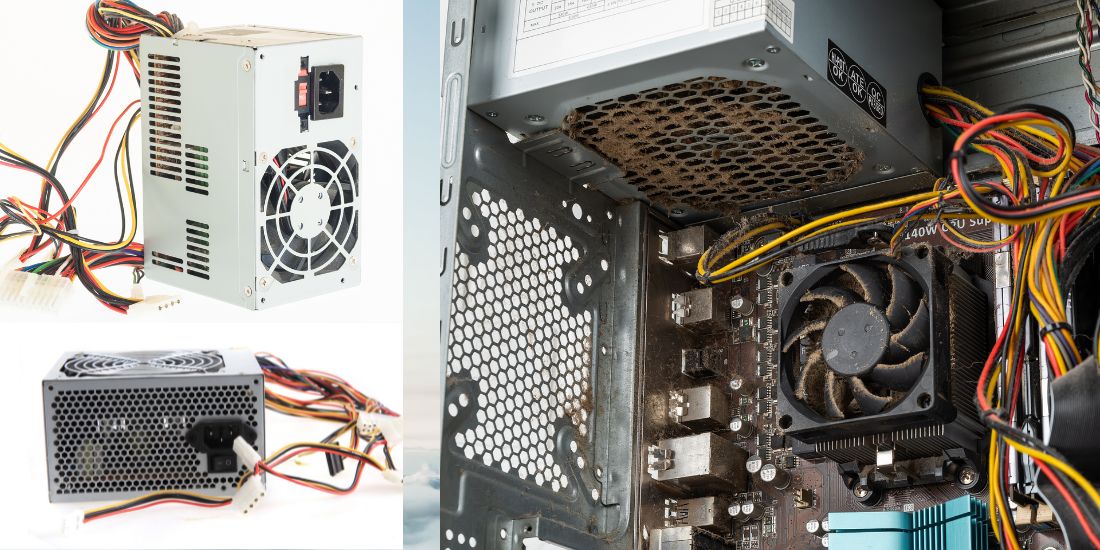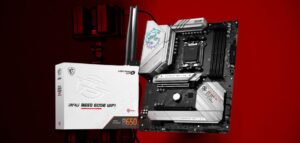How to Check Which PSU You Have?
Welcome to our comprehensive guide on how to check which PSU (Power Supply Unit) you have. Whether you’re a tech enthusiast, a gamer, or simply someone seeking to better understand your computer, knowing your PSU is essential. If you’re unsure about the type or specifications of your PSU, you’ve come to the right place. This guide will walk you through the process of identifying your PSU and ensuring it meets the necessary criteria for your system’s performance and stability.
Your PSU, often an overlooked component, plays a crucial role in powering your computer and maintaining its overall functionality. Proper knowledge of your PSU’s specifications is vital to ensure your system runs smoothly and efficiently. By following our step-by-step instructions, you will learn how to locate and read the PSU label, use a tester, and measure voltages if needed. By the end of this article, you’ll have a clear understanding of your PSU’s capabilities and whether it meets your computer’s requirements. This understanding is key to preventing potential issues and ensuring your computer remains robust and reliable. Let’s dive in and get started on identifying your PSU.
What is a Power Supply Unit (PSU)?
A Power Supply Unit (PSU) is a critical hardware component in a computer that converts alternating current (AC) from the wall outlet into the direct current (DC) required by the various internal components. The PSU is responsible for providing the necessary power to the motherboard, CPU, RAM, storage drives, and other peripherals. Modern PSUs are typically switched-mode power supplies, which offer improved efficiency and the ability to operate on different input voltages. The PSU has various voltage rails, such as +3.3V, +5V, and +12V, that supply power to the different components based on their specific requirements. The PSU also includes a fan to dissipate the heat generated during operation. Selecting the right PSU wattage and ensuring it is compatible with the rest of the system is crucial for stable and reliable computer performance.
Why Knowing Your PSU Matters?
Knowing your PSU (Power Supply Unit) matters for several reasons:
- Performance and Efficiency: A PSU with adequate wattage ensures that your system operates efficiently and at optimal performance. Insufficient wattage can lead to inefficiencies, disruptions, or even damage.
- Safety: A PSU with the right wattage ensures that your system operates safely. Overloading a PSU can cause overheating, which can lead to system failure or even fire hazards.
- Future Upgrades: Knowing your PSU wattage helps you plan for future upgrades. For example, if you plan to upgrade your graphics card, you need to ensure that your PSU can handle the increased power requirements.
- System Stability: A PSU with the right wattage helps maintain system stability. Underestimating your power demand can lead to system instability or failure.
- Cost Savings: Choosing the right PSU wattage helps you avoid unnecessary expenses. Overbuying a PSU can be costly, and underbuying can lead to inefficiencies and potential damage.
- Environmental Impact: A PSU with the right wattage helps reduce environmental impact. Overloading a PSU can lead to increased energy consumption and heat generation, contributing to environmental issues like climate change.
- System Compatibility: Knowing your PSU wattage ensures compatibility with other system components. For example, a PSU with insufficient wattage may not be compatible with certain graphics cards or other components.
- Troubleshooting: Knowing your PSU wattage helps in troubleshooting system issues. For example, if your system is experiencing performance issues, checking the PSU wattage can help identify the root cause.
- Warranty and Support: Knowing your PSU wattage helps you take advantage of warranty and support services. Manufacturers often provide specific guidelines for PSU wattage and compatibility, and knowing this information helps you ensure you are within those guidelines.
- Equipment Lifespan: A PSU with the right wattage helps extend the lifespan of your equipment. Overloading a PSU can reduce its lifespan and potentially cause premature failure
How to Check Which PSU You Have?
If you’re having issues with your computer’s performance or stability, one of the first things you should check is the power supply unit (PSU). The PSU is responsible for providing power to all the components in your system, and if it’s not providing enough or is malfunctioning, it can cause all sorts of problems. Fortunately, checking which PSU you have is a relatively simple process. In this blog post, we’ll walk you through several methods to identify your PSU, from looking at the label to using a multimeter. By the end, you’ll know exactly which power supply is powering your rig.
Look at the Label:
The easiest way to identify your PSU is to simply look at the label on the side of the unit. This label will typically include the model number, wattage, and other key specifications. To check the label:
- Open up your computer case and locate the PSU, usually mounted at the back of the case.
- Look on the side of the PSU for a label that has the model number and wattage printed on it in large text. For example, it may say “Corsair CX600 600W”.
- If you can’t find the label on the side, check the rear of the PSU as the information is sometimes printed there in smaller text.
- Make a note of the model number and wattage so you can reference it later.
Check the Box or Manual:
If you still have the original box your PSU came in or the manual, you can check those for the model number and specs. The box will usually have the model and wattage printed prominently on it. The manual will have all the technical details about your specific PSU model.
Look Up the Model Number:
Once you have the model number, you can look it up online to get the full specifications. Most major PSU manufacturers like Corsair, EVGA, Seasonic, etc. have a support section on their website where you can enter the model number and it will tell you the wattage, connectors, and other details.
Use a PSU Tester:
If you have a power supply tester, you can use that to check your PSU. A PSU tester is a small device that plugs into the 24-pin motherboard connector and has lights that indicate if the PSU is outputting the correct voltages. To use a PSU tester:
- Unplug all the cables from your PSU except the 24-pin motherboard cable.
- Plug the PSU tester into the 24-pin connector.
- Turn on the PSU using the switch on the back.
- The tester will light up and show if the voltages are within spec. Refer to the tester’s instructions for the exact meaning of the lights.
Do a Paperclip Test:
If you don’t have a PSU tester, you can do a simple paperclip test to see if the PSU is turning on at all. This won’t give you the wattage or model, but it can help determine if the PSU is completely dead. To do the paperclip test:
- Unplug the PSU from the wall and remove it from the case.
- Locate the green wire (usually wire #16) and a nearby black wire (ground) on the 24-pin motherboard connector.
- Use a bent paperclip to shorten the green wire to a black wire. This tricks the PSU into thinking the system is turned on.
- Plug in the PSU to the wall and turn it on. If the PSU’s fan spins up, it’s likely working. If not, the PSU may be dead.
Use a Multimeter:
Another way to test the PSU is with a multimeter. This allows you to measure the actual voltages being output by the PSU. To test with a multimeter:
- Set your multimeter to measure DC voltage.
- Unplug the PSU from the wall and remove it from the case.
- Locate the 24-pin motherboard connector on the PSU.
- Use the multimeter to measure the voltage between the green wire (power on) and a black wire (ground). It should read around 5V.
- Measure the voltages on the 12V rails (yellow wires) and 5V rails (red wires). Compare to the PSU’s specs.
- If any voltages are way off, the PSU may be faulty.
Check the Wattage:
Once you know the model number, you can look up the wattage of your specific PSU. This will tell you how much power it can provide to your system. The wattage is usually printed in large text on the PSU label or box. For example, it may say “Corsair CX600 600W” indicating it’s a 600-watt power supply.
Determine if You Need More Power:
Knowing the wattage of your PSU is important to determine if it’s providing enough power for your system. If you’ve recently upgraded components like the graphics card, you may need more wattage. To check if your PSU is sufficient:
- Add up the estimated power draw of all your components. You can find this info in the component specs or online calculators.
- Compare the total to your PSU’s wattage. The PSU should have at least 20-30% more wattage than the estimated total.
- If your PSU is underpowered, you’ll need to upgrade to a higher-wattage model.
Understanding Your PSU’s Specifications:
Here are the key points to understand about your PSU’s specifications:
1. Form Factor
- The form factor refers to the physical size and shape of the PSU. Common form factors include ATX, SFX, and FlexATX. The form factor must match your computer case to ensure proper fitment.
2. Wattage
- The wattage rating is the maximum output the PSU can supply. It should be sufficient to power all the components in your system with some overhead. As a general rule, choose a PSU with about 100W more capacity than your system requires.
3. 80 Plus Certification
- This indicates the PSU meets certain efficiency standards. Higher certifications like Gold, Platinum, and Titanium mean the PSU wastes less power during the AC to DC conversion process. More efficient PSUs generate less heat and save on electricity costs.
4. Voltage Rails
- The voltage rails are the different DC voltages supplied by the PSU, typically +3.3V, +5V, and +12V. Components like the CPU, GPU, and drives draw power from these rails. Ensure your components are compatible with the rails provided.
5. Ripple and Noise
- Ripple and noise specifications indicate the cleanliness of the DC power. Lower ripple and noise values, usually under 50mV peak-to-peak, are desirable to avoid interference with sensitive components.
6. Temperature Stability
- This spec shows how much the output voltage varies with temperature changes. Figures around 0.02%/°C or 2mV/°C are typical. Temperature stability is important for maintaining consistent power delivery
How to Make Use of Your PSU Information:
Upgrading Your Components:
If you’re planning to upgrade your computer, knowing your PSU’s wattage is critical. Here’s how to use this information:
Check Component Requirements:
- Before purchasing new components, like a graphics card or CPU, review their power requirements in the product specifications. Ensure your PSU’s wattage exceeds these requirements to avoid compatibility issues.
Connector Compatibility:
- Different PSUs come with various connectors. Check if your PSU has the necessary connectors for your new components, such as PCIe connectors for graphics cards.
Energy Efficiency and Environmental Impact:
Understanding your PSU’s efficiency rating can also be valuable:
Save on Energy Bills:
- Higher efficiency PSUs are more energy-efficient and can lead to lower electricity bills over time.
Reducing Environmental Impact:
- Energy-efficient PSUs consume less power, which reduces your carbon footprint and helps the environment.
Conclusion on Check Which PSU You Have?
In conclusion, identifying your PSU (Power Supply Unit) is an essential troubleshooting step when facing computer issues. By examining the label on the PSU, using a tester, or measuring voltages with a multimeter, you can accurately determine your PSU’s model and wattage. This information is crucial for assessing whether your power supply meets your system’s needs or if an upgrade is necessary. An inadequate or faulty PSU can lead to various problems, including random shutdowns and system instability.
Ensuring that your PSU is sufficient and functioning properly is vital for the overall health and performance of your computer. Remember, the PSU is the heart of your PC, supplying power to all components and enabling smooth operation. Don’t overlook the importance of this component; regular checks and proper maintenance can prevent future issues and extend the lifespan of your system. By prioritizing your PSU, you can enhance the reliability and efficiency of your computer, ensuring it remains robust and operational.
FAQs
1. What do I do if my PSU doesn’t have a label or it’s too faded to read?
If you can’t find information on your PSU label, try using system information software or consult your computer’s documentation.
2. Is it safe to open my computer case to check the PSU?
It’s safe as long as you take precautions. Ensure the computer is powered off and unplugged, and follow proper anti-static procedures.
3. What’s the difference between modular and non-modular PSUs?
Modular PSUs allow you to detach unused cables, helping with cable management and airflow inside your case. Non-modular PSUs have fixed cables.
4. Can I upgrade my PSU myself?
Yes, you can upgrade your PSU yourself, but if you’re not confident in your skills, it’s best to seek professional help to ensure a safe installation.
5. What is 80 PLUS certification, and is it important?
The 80 PLUS certification indicates the efficiency of a PSU. It’s important if you want to save on energy bills and reduce environmental impact. Higher ratings are more efficient.
Last Updated on 3 June 2024 by Ansa Imran

Ansa Imran, a writer, excels in creating insightful content about technology and gaming. Her articles, known for their clarity and depth, help demystify complex tech topics for a broad audience. Ansa’s work showcases her passion for the latest tech trends and her ability to engage readers with informative, well-researched pieces.







